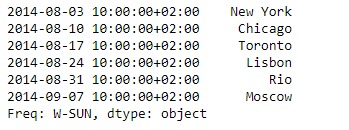Pandas 系列是带有轴标签的一维ndarray。标签不必是唯一的,但必须是可哈希的类型。该对象同时支持基于整数和基于标签的索引,并提供了许多方法来执行涉及索引的操作。
Pandas Series.to_csv()函数将给定的系列对象写入以逗号分隔的值(csv)文件/格式。
用法: Series.to_csv(*args, **kwargs)
参数:
path_or_buf:文件路径或对象,如果提供None,则结果以字符串形式返回。
sep:长度为1的字符串。输出文件的字段定界符。
na_rep:缺少数据表示。
float_format:浮点数的格式字符串。
columns:要写的专栏
header:如果给出了字符串列表,则假定它是列名的别名。
index:写行名(索引)。
index_label:索引列的列标签(如果需要)。如果没有给出,并且标头和索引为True,则使用索引名称。
mode:Python写入模式,默认为“ w”。
encoding:一个字符串,表示要在输出文件中使用的编码。
compression:压缩模式包括以下几种可能的值:{'infer','gzip','bz2','zip','xz',无}。
quoting:默认为csv.QUOTE_MINIMAL。
quotechar:长度为1的字符串。用于引用字段的字符。
返回:无或str
范例1:采用Series.to_csv()函数将给定的系列对象转换为csv格式。
# importing pandas as pd
import pandas as pd
# Creating the Series
sr = pd.Series(['New York', 'Chicago', 'Toronto', 'Lisbon', 'Rio', 'Moscow'])
# Create the Datetime Index
didx = pd.DatetimeIndex(start ='2014-08-01 10:00', freq ='W',
periods = 6, tz = 'Europe / Berlin')
# set the index
sr.index = didx
# Print the series
print(sr)输出:

现在我们将使用Series.to_csv()函数将给定的Series对象转换为逗号分隔的格式。
# convert to comma-seperated
sr.to_csv()输出:

正如我们在输出中看到的,Series.to_csv()函数已将给定的Series对象转换为逗号分隔的格式。
范例2:采用Series.to_csv()函数将给定的系列对象转换为csv格式。
# importing pandas as pd
import pandas as pd
# Creating the Series
sr = pd.Series([19.5, 16.8, None, 22.78, None, 20.124, None, 18.1002, None])
# Print the series
print(sr)输出:

现在我们将使用Series.to_csv()函数将给定的Series对象转换为逗号分隔的格式。
# convert to comma-seperated
sr.to_csv()输出:

正如我们在输出中看到的,Series.to_csv()函数已将给定的Series对象转换为逗号分隔的格式。
相关用法
- Python pandas.map()用法及代码示例
- Python Pandas dataframe.sem()用法及代码示例
- Python Pandas Series.abs()用法及代码示例
- Python Pandas Series.sum()用法及代码示例
- Python Pandas dataframe.sub()用法及代码示例
- Python Pandas TimedeltaIndex.contains用法及代码示例
- Python Pandas Series.eq()用法及代码示例
- Python Pandas Series.ne()用法及代码示例
- Python Pandas Series.ge()用法及代码示例
- Python Pandas dataframe.std()用法及代码示例
- Python Pandas Timestamp.day用法及代码示例
- Python Pandas Series.lt()用法及代码示例
- Python Pandas Series.le()用法及代码示例
- Python Pandas Series.take()用法及代码示例
- Python Pandas Series.all()用法及代码示例
注:本文由纯净天空筛选整理自Shubham__Ranjan大神的英文原创作品 Python | Pandas Series.to_csv()。非经特殊声明,原始代码版权归原作者所有,本译文未经允许或授权,请勿转载或复制。
